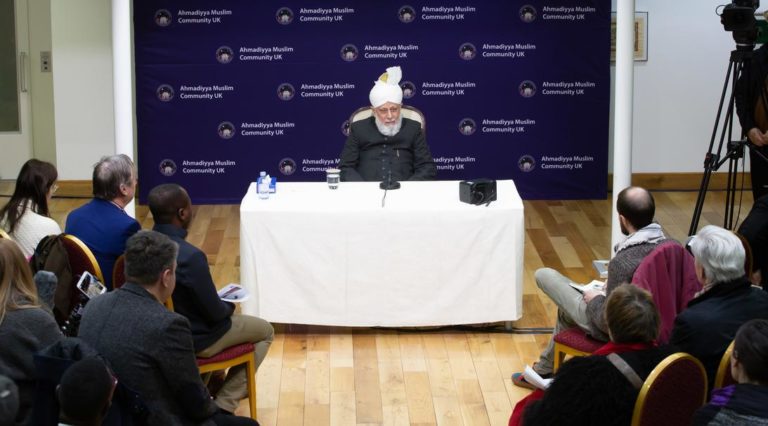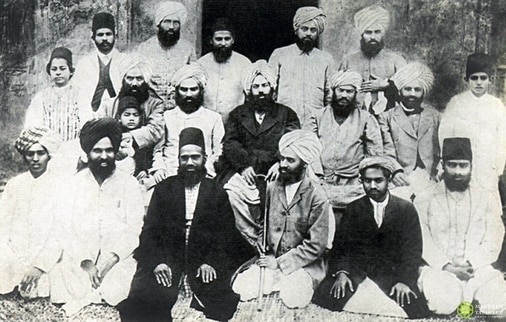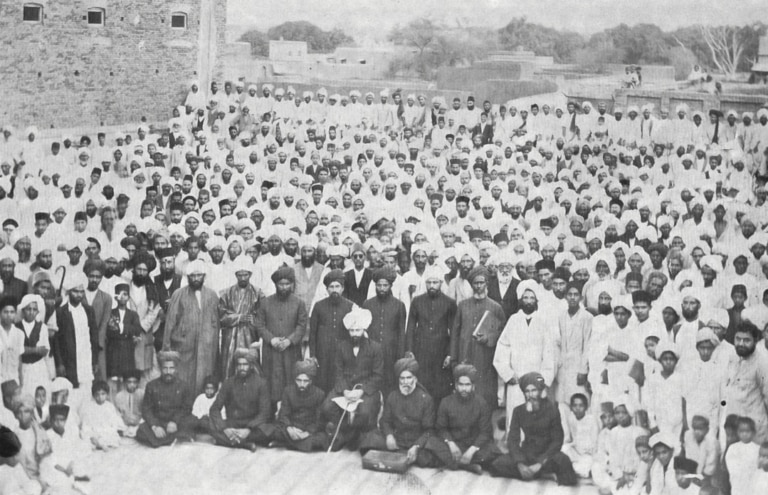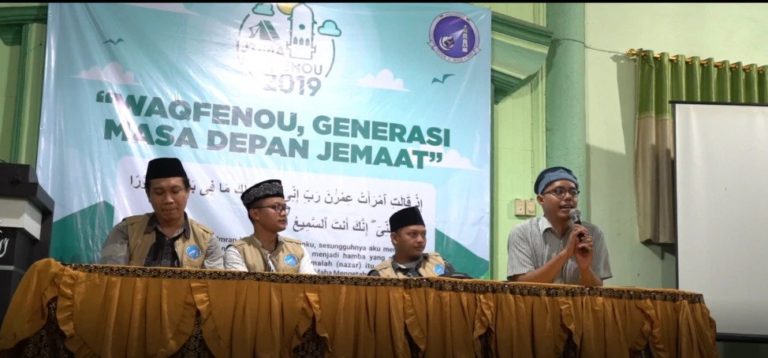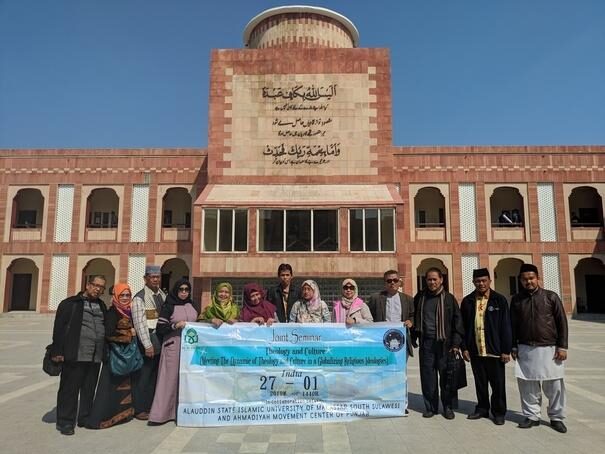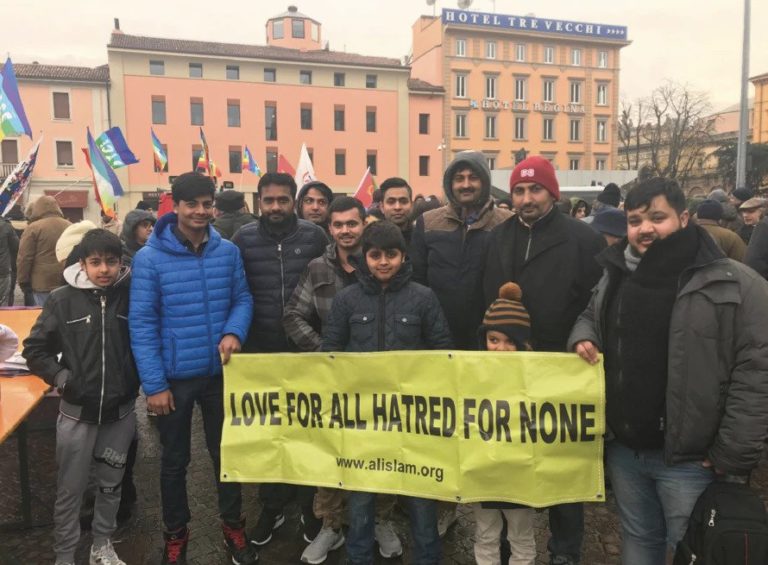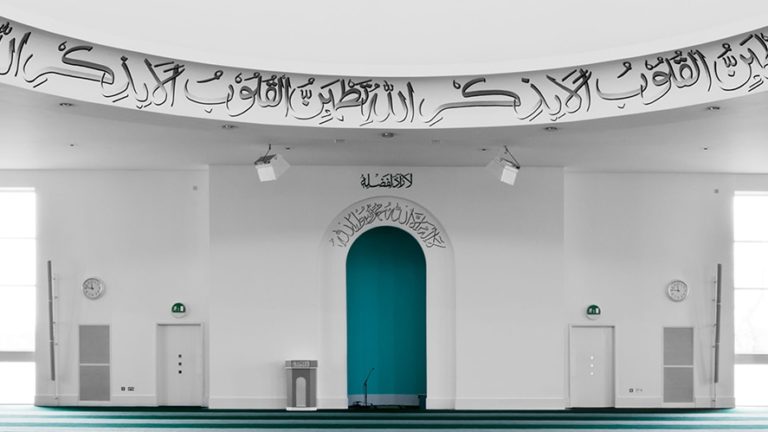Friday Sermon
15 February 2019
Men of Excellence
After reciting the Tashahud, Ta‘awuz, and Surah al-Fatihah, Hazrat Khalifatul Masih Vaa stated:
The name of the first companion that I will mention today is Hazrat Khalidra bin Qais. Hazrat Khalidra belonged to the Banu Bayada branch of the Khazraj tribe. His father’s name was Qais bin Malik and his mother’s name was Salma bint Harithah. His wife was Umme Rabee and they had a son called Abdur Rahman. According to Ibn Ishaq, he participated in the pledge that took place at Aqabah along with 70 companions from among the Ansar. Hazrat Khalidra also participated in the Battles of Badr and Uhud. (Al-Tabaqaat-ul-Kubra, Vol. 3, pp. 449-450, Khalid bin Qaisra, Dar-ul-Kutub Al-Ilmiyyah, Beirut, 1990)
The second companion is Hazrat Harisra bin Khazama Ansari. His title was Abu Bishr and he belonged to the Khazraj tribe of the Ansar, who were confederates of the Banu Abdil Ash‘hal tribe. Hazrat Haris bin Khazamara participated in all of the battles alongside the Holy Prophetsa including the battles of Badr, Uhud and Khandaq [the ditch]. The Holy Prophetsa established a bond of brotherhood between Hazrat Haris bin Khazamara and Hazrat Iyas bin Bukairra.
In the accounts of history it states that during the Battle of Tabuk, the Holy Prophet’ssa camel went missing. The hypocrites raised the allegation against the Holy Prophetsa saying, “How can he have knowledge of the Heavens when he does not even know where his camel is?” When the Holy Prophetsa came to know about this, he said, “I only possess knowledge of those matters which God has informed me of.” The Holy Prophetsa then said that God had informed him about his camel and that it was in the mountain pass of a certain valley. This incident has been mentioned before as well, in reference to another companion. The companion who went in search of the camel according to the instructions of the Holy Prophetsa and brought it back was Hazrat Haris bin Khazamara. He passed away in Medina in 40 AH during the Khilafat of Hazrat Ali at the age of 67. (Usdul Ghaba, Vol. 1, pp. 602-603, Al-Harith bin Khazamara, Dar-ul-Kutub Al-Ilmiyyah, Beirut, 2003) (Al-Isabatu Fi Tamyiz Al-Sahaba, Vol. 1, p. 666, Al-Harith bin Khazamara, Dar-ul-Kutub Al-Ilmiyyah, Beirut, 1995)
The next companion to be mentioned is Hazrat Khunaisra bin Huzafah. His title was Abu Huzafah. His mother’s name was Da‘ifah bint Hizyam. He belonged to Bani Saham bin Amr tribe. He accepted Islam before the Holy Prophetsa went to Dar-e-Arqam. Hazrat Khunaisra was the brother of Hazrat Abdullah bin Huzafahra. Hazrat Khunaisra was among those Muslims who participated in the second migration to Abyssinia. He is considered among the foremost of the Muhajireen. When Hazrat Khunaisra first migrated to Medina, he stayed with Hazrat Rifa‘ah bin Abdil Munzirra. The Holy Prophetsa established a bond of brotherhood between Hazrat Khunaisra and Hazrat Abu Abs bin Jabarra. Hazrat Khunaisra participated in the Battle of Badr. Ummul Momineen, Hazrat Hafsahra was married to Hazrat Khunaisra before she married the Holy Prophetsa (Al-Tabaqaat-ul-Kubra, Vol. 3, p. 300, Khunais bin Huzafahra, Dar-ul-Kutub Al-Ilmiyyah, Beirut, 1990) (Usdul Ghaba, Vol. 2, p. 188, Khunais bin Huzafahra, Dar-ul-Kutub Al-Ilmiyyah, Beirut, 2003).
The details of this are recorded in Sirat Khatamun-Nabiyyin [The Life & Character of the Seal of Prophets by Hazrat Mirza Bashir Ahmadra] as follows:
“Hazrat Umarra had a daughter by the name of Hafsahra who was married to a faithful companion, Khunais bin Huzafah, who had taken part in the Battle of Badr. After Badr, upon returning to Medina, Khunais fell ill. He was unable to recover from his illness and passed away. Sometime after his demise, Hazrat Umarra began to feel a sense of concern for her second marriage. At the time, Hafsahra was over twenty years of age. Due to his simplicity in nature, Hazrat Umarra met Uthman bin Affanra himself and mentioned that his daughter Hafsahra was now a widow, and that if he was interested, he could marry her. However, Hazrat Uthmanra avoided the subject. After this, Hazrat Umarra mentioned it to Hazrat Abu Bakrra, but he too remained silent and did not respond. At this, Hazrat Umarra was deeply saddened, and in this very state of dismay, he presented himself before the Holy Prophetsa and submitted the entire account. The Holy Prophetsa responded, ‘O Umar! Do not worry at all, if Allah so wills, Hafsah shall find a better husband than Uthman and Abu Bakr; and Uthman shall receive a better wife than Hafsah.’ The Holy Prophetsa said this because he had already intended to marry Hafsahra and to give his own daughter Umme Kulthumra to Hazrat Uthmanra in marriage. Both Hazrat Uthmanra and Hazrat Abu Bakrra were aware of this (they had already been told) and this is why they turned down the proposal of Hazrat Umarra. Sometime thereafter, the Holy Prophetsa married his daughter Umme Kulthumra to Hazrat Uthmanra, and this has already been mentioned above. Following this, the Holy Prophetsa sent a proposal himself to Hazrat Umarra for Hafsahra. What more could Hazrat Umarra have asked for? He very happily accepted this proposal. In Sha‘ban 3 AH, Hazrat Hafsahra was married to the Holy Prophetsa and became a part of his household. When this marriage had taken place, Hazrat Abu Bakrra said to Hazrat Umarra:
‘Perhaps your heart has been saddened on my account.’” Perhaps due to some grief and a feeling of resentment had formed in his heart). “‘The fact is, that I was already aware of the intention of the Holy Prophetsa, but I could not reveal his secret without permission (of the Holy Prophetsa). Of course, if the Holy Prophetsa had not intended so, I would have most gladly married Hafsah.’
One special wisdom in marrying Hafsahra was that she was the daughter of Hazrat Umarra, who one could say was considered to be the most eminent companion after Hazrat Abu Bakrra, and he was from among the most intimate friends of the Holy Prophetsa. Hence, in order to further strengthen mutual relations and to alleviate the grief of Hazrat Umarra and Hafsahra, which they had sustained by the untimely demise of Khuanis bin Huzafahra, the Holy Prophetsa deemed it appropriate to marry Hafsahra himself.” (Sirat Khatamun-Nabiyyin, Hazrat Mirza Bashir Ahmadra, pp. 477-478)
According to another narration, Hazrat Khuanis bin Huzafahra was wounded during the battle of Uhud and sometime later, he passed away in Medina as a result of these wounds. The Holy Prophetsa led his funeral prayer and he was buried in Jannat-ul-Baqi, next to Hazrat Uthman bin Maz‘unra. (Al-Isti‘aab Fi Ma’rifati Al-Sahaba, Vol. 2, p. 452, Khuanis bin Huzafahra, Dar-ul-Jeel, Beirut, 1992) (Al-Tabaqaat-ul-Kubra, Vol. 3, p. 300, Khunais bin Huzafahra, Dar-ul-Kutub Al-Ilmiyyah, Beirut, 1990)
The next companion is Hazrat Haritha bin Nu‘manra and his title was Abu Abdullah. Hazrat Haritha bin Nu‘manra was an Ansari companion and belonged to the Banu Najjar clan of the Khazraj tribe. He participated alongside the Holy Prophetsa in all battles including the battles of Badr, Uhud and Khandaq. He is considered among the prominent companions. Hazrat Haritha’s mother was Jadah bint Ubaid. The children of Hazrat Haritha bin Nu‘man are as follows: Abdullah, Abdur Rahman, Saudah, Umrah and Umme Hisham. Their mother’s name was Umme Khalid. His other children include Umme Kulthum, whose mother belonged to the tribe of Banu Abdullah bin Ghatfan and Amatullah, whose mother belonged to the Banu Jundu tribe.
In another narration, Ibn Abbas relates that Hazrat Haritha bin Nu‘man passed by the Holy Prophetsa and at the time, Gabrielas was sitting beside him. In reference to this incident, there is a brief narration which is as follows:
“Hazrat Haritha bin Nu‘manra passed by the Holy Prophet and offered his Salam to which Gabriel replied, ‘Wa alaikumussalam.’”
However, a detailed narration of this incident is as follows:
“Hazrat Ibn Abbas relates that Hazrat Haritha bin Nu‘manra passed by the Holy Prophetsa while Hazrat Gabrielas was sitting beside him and the Holy Prophetsa was speaking to him in a low voice. Hazrat Harithara did not say Salam to the Holy Prophetsa and Gabriel asked why he did not say Salam? Afterwards, the Holy Prophetsa enquired from Harithara “When you were passing by, why did you not say Salam?” He replied, ‘I saw a person beside you and you were speaking to him in a low voice. I did not deem it appropriate to interrupt your conversation,’ i.e. he did not want to cause the Holy Prophet to divert his attention by saying Salam. The Holy Prophetsa asked, ‘Did you see the person sitting beside me?” He replied in the affirmative. Upon this the Holy Prophetsa said: “It was Gabrielas and he said that had that person extended the greeting of Salam, he would have replied to his greeting. Following this, Gabrielas said, ‘He is among those eighty individuals.’ The Holy Prophetsa then asked Gabrielas for the meaning of this to which Gabrielas replied, “He is among those eighty individuals who remained steadfast alongside you during the Battle of Hunain. The responsibility of providing for him and providing for his offspring in paradise lies with God Almighty.’”
Hence, the Holy Prophetsa mentioned all of this to Hazrat Harithara.
Hazrat Aishara relates that the Holy Prophetsa had great respect and honour for Hazrat Harithara. Hazrat Aishara has also spoken about him with regard to his excellent treattent towards his mother and the Holy Prophetsa advised that everyone ought to follow his virtuous example.
Hazrat Haritha bin Nu‘man’s eye sight worsened gradually and towards his last years, he lost his sight. He had tied a rope from the praying area to the door of his room and he used to keep a basket full of dates with him. Whenever a poor person, someone in need or a guest would come to see him and say Salam, or whenever he considered someone to be in need, he would use that rope to walk from his prayer room to the door and give them some dates. His family members used to say to him that they could help him and carry it out on his behalf as his vision was worsening, and he did not need to burden himself. However, he used to say, “I heard from the Holy Prophetsa that helping the needy safeguards a person from an evil death.”
It has been mentioned in a narration that Hazrat Haritha bin Nu‘man had a few houses which were situated close to the houses of the Holy Prophetsa. He owned several homes and properties in Medina and whenever there was a need, he would offer his properties to the Holy Prophetsa. (Al-Tabaqaat-ul-Kubra, Vol. 3, pp. 371-372, Haritha bin Nu’manra, Dar-ul-Kutub Al-Ilmiyyah, Beirut, 1990) (Usdul Ghaba, Vol. 1, pp. 655-656, Haritha bin Nu’manra, Dar-ul-Kutub Al-Ilmiyyah, Beirut, 2003)
In other words, whenever a need arose, for instance if there was a marriage, or for any other reason, he would offer his home, in fact he would donate it. When Hazrat Alira married Hazrat Fatimahra, the Holy Prophetsa instructed Hazrat Alira to search for a separate house for himself. Therefore, Hazrat Alira found a place of his own and settled there with Hazrat Fatimahra after their marriage. Following this, the Holy Prophetsa said to Hazrat Fatimahra, “I wish to bring you close to me.” That is, for her to move closer to the Holy Prophetsa.
Hazrat Fatimahra suggested to the Holy Prophetsa if he could ask Haritha bin Nu‘man to move elsewhere and they could move into his house. The Holy Prophetsa replied, “Harithara has moved for me on a number of occasions. He has some properties nearby and always vacates those properties for me. Therefore, I feel embarrassed to ask him to move again.” When Hazrat Harithara heard this, he moved out of his house to a new property. He then came to the Holy Prophetsa and stated, “O Messengersa of Allah! I heard that you would like for Hazrat Fatimahra to move close to you. These houses of mine are the closest to your home from amongst all the houses of the Banu Najjar. My wealth and I are all for the sake of Allah and His Messengersa. O Messengersa of Allah, please take any wealth of mine that you wish. Whatever you leave for me will be dearer to me than any wealth.” The Holy Prophetsa stated, “Indeed you have spoken the truth. May God shower his blessings upon you.” Hence, the Holy Prophetsa asked Hazrat Fatimahra to move into the house of Hazrat Harithara.” (Al-Tabaqaat-ul-Kubra, Vol. 8, pp. 18-19, Fatimah bint Rasulillahra, Dar-ul-Kutub Al-Ilmiyyah, Beirut, 1990)
Hazrat Mirza Bashir Ahmadra has written some further details to this incident in Sirat Khatamun-Nabiyyin [The Life & Character of the Seal of Prophets]. He writes:
“Until now, Hazrat Alira perhaps lived with the Holy Prophetsa in an apartment built next to the mosque. However, a separate abode was now required, where husband and wife could reside after marriage. Therefore, the Holy Prophetra instructed Hazrat Alira to find a place where both of them could reside. Hazrat Alira temporarily arranged for a home and the rukhsatana [marriage]of Hazrat Fatimahra took place. On the very same day, after the rukhsatana, the Holy Prophetsa visited their new home and called for some water to be brought to him, prayed on it and then sprinkled it on both Hazrat Fatimahra and Hazrat Alira, whilst repeating the following words:
اَللّٰهُمَّ بَارِكْ فِيْهِمَا وَبَارِكْ عَلَيْهِمَا وَبَارِكْ لَهُمَا نَسْلَهُمَا
Meaning, ‘O my Allah! Bless the mutual relations of both of them, and bless the relations of both which are built with others and bless their progeny.’” That is, he prayed for their mutual relations, their relations with their family members and the society at large. He prayed for their progeny to be blessed. “‘After this, the Holy Prophetsa left the newly wedded couple alone and returned. Afterwards, one day, when the Holy Prophetsa came to visit Hazrat Fatimahra, she submitted to the Holy Prophetsa that Haritha bin Nu‘man Ansarira was in possession of a few homes, and asked if the Holy Prophetsa would request him to vacate one of them. The Holy Prophetsa said, ‘He has already vacated so many homes for our sake. Now I feel embarrassed in requesting more of him.’ In some way or another, when Harithara happened to find out about this, he came running to the Holy Prophetsa and submitted, ‘O Messenger of Allah! Everything I own belongs to you, my Master. By God, whatever you accept of me causes me greater joy then that which remains with me.’ Then, this faithful companion insisted and vacated one of his homes, and presented it to the Holy Prophetsa. After this, Hazrat Alira and Hazrat Fatimahra moved to this home.” (Sirat Khatamun-Nabiyyin, Hazrat Mirza Bashir Ahmadra, p. 456)
Hazrat Aishara narrates:
“On the day of Hunain, the Holy Prophetsa addressed the Companions and stated: ‘Who amongst you will be on watch at night?’ Hazrat Haritha bin Nu‘manra stood up slowly and calmly. It was not his habit to rush through anything. The Companions commented on the slow and relaxed manner in which he stood up stating: ‘His modesty has tainted his habits. He should have stood up quickly on this occasion.’ The Holy Prophetsa stated: ‘Do not say such a thing, rather, it would be true to say that modesty has saved Haritha.’ (Al-muntaqa Min Kitab Makarim Al-Akhlaq lil-Khara’iti, p. 68, Bab Fadeelatil Hayaa Wa Jaseem Khatarahu, Hadith 127, Darul Fikr, Damascus, 1988).
Hazrat Haritha bin Nu‘man passed away during the rule of Hazrat Amir Muawiyah. (Al-Tabaqaat-ul-Kubra, Vol. 3, p. 372, Haritha bin Nu’manra, Dar-ul-Kutub Al-Ilmiyyah, Beirut, 1990)
The next companion is Hazrat Bashir bin Sa‘dra. His title was Abu Nu’man. His father was Sa‘d bin Thalbah, and his brother’s name was Hazrat Simaak bin Sa‘d. Hazrat Bashir bin Sa‘dra belonged to the Khazraj tribe (Al-Isti‘aab Fi Ma’rifati Al-Sahaba, Vol. 1, p. 172, Bashir bin Sa’dra, Dar-ul-Jeel, Beirut, 1992). His mother was Unaisah bint Khalifah, and his wife was Amrah bint Rawahah. Hazrat Bashir bin Sa‘dra knew how to read and write during the period of Jahiliyyah [era prior to the advent of Islam], a time when very few among the Arabs literate. He took part in the second Bai‘at at Aqabah along with seventy companions. He participated in all battles alongside the Holy Prophetsa including the battles of Badr, Uhud and Khandaq.
In Shaban 7 AH, the Holy Prophetsa sent an expedition of thirty companions to Fadak towards the Bani Murrah tribe under the leadership of Hazrat Bashir bin Sa‘dra. An intense battle ensued in which Hazrat Bashirra fought valiantly. During the battle, he was struck on his ankle with a sword and it was assumed that he had been martyred. The enemies had left him as they thought that he was unconscious or had been killed. However, in the evening he regained consciousness and came to Fadak where he stayed a few days in the home of a Jewish man, before returning to Medina.
Similarly, in Shawal 7 AH, the Holy Prophetsa sent him along with three hundred men into Yuman and Jubar which are located between Fadak and the Valley of Quraa. This was the place where some people of Ghatfan had gathered with Uainah bin Hisan Al Fazari and were devising schemes against Islam. Hazrat Bashirra confronted them and [as a result] they dispersed. Some from among them were killed by the Muslim army and some were taken captive. They returned [to Medina] with the spoils of war (Al-Tabaqaat-ul-Kubra, Vol. 3, pp. 402-403, Bashir bin Sa’dra, Dar-ul-Kutub Al-Ilmiyyah, Beirut, 1990). This expedition was a precautionary measure because these people were making plans to attack the Muslims and cause them harm. The purpose was not to kill them or to loot their wealth. As I mentioned in my previous sermon that on one occasion, the Holy Prophetsa expressed great displeasure when some companions launched an unjustified attack and questioned them as to why they did so.
There is a narration about Bashir bin Sa‘dra from his son, Hazrat Nu‘man bin Bashirra in which he said that his father brought him to the Holy Prophetsa and stated: “I have granted a servant to this son of mine.” The Prophet of Allahsa enquired: “Have you granted the same to all your sons?” He said: “No.” The Holy Prophetsa then stated: “Then you should take the servant back.” (Sahih Bukhari, Kitabul Hiba, Bab Al Hibatu Lil Walad, Hadith 2586)
According to another narration, Hazrat Nu‘man bin Bashir states: “My father bestowed some of his wealth to me.” Both these narrations are from Bukhari. “My mother, Amrah bint Rawahah stated: ‘I will not be satisfied until you request the Holy Prophetsa to be a witness regarding this matter.’ My father came to the Holy Prophetsa in order to request him to become a witness about the gift he had bestowed to me. The Holy Prophetsa stated: ‘Have you given the same to all of your children?’” Meaning, have you given everyone the same amount of wealth or the same gift? “He responded: ‘No.’ The Holy Prophetsa then said: ‘Fear Allah and treat your children in a just manner.’ My father returned and took the gift back.” (Sahih Bukhari, Kitabul Hiba, Babul Ash’haad, Hadith 2587)
Regarding this narration, in Sahih Muslim it is written that the Holy Prophetsa said: “Do not ask me to be a witness about this, because I cannot be a witness over a transgression.” (Sahih Muslim, Kitabul Hibaat, Karahiyyatu Tafdeel Ba‘d Awlaad Fil Hibati, Hadith 4182)
While commenting upon this issue or elaborating on this Hadith and explaining the act of giving a gift of this sort, Hazrat Musleh-e-Maudra has very eloquently explained this, which serves as an excellent source of guidance. He states:
“In my opinion this instruction of the Holy Prophetsa is regarding significant things and not about small trivial matters. For example, if one is eating a banana and decides to share it with one of the children present at the time, it is possible that the other children will be deprived of it. The examples used in the Hadith of the Holy Prophetsa are that of horses, money or slaves; i.e. something that has value. The Holy Prophetsa said to one person that he ought to either give a horse to each one of his sons or not to give it to anyone. The reason for this was that in Arabia, horses were of great value.” Slaves were also considered property and the same is true for any other wealth. Therefore, this prohibition is for expensive possessions and Arabs considered horses to be precious. “Thus, this commandment is about the things which can cause mutual enmity to take root in the hearts.”
If a person gives something to one child and does not give the same to the others, this can become a source of contention between them. Hazrat Musleh-e-Maudra states:
“This injunction is not for insignificant things. For example, if we take one child to the market place and purchase a piece of cloth for their coat, it is perfectly permissible. It cannot be said that until we purchase coats for all the children no one should be given anything.”
He further states: “Sometimes, it so happens that we receive a gift and the child present at the time asks for that gift to be given to him and we comply with their request. This does not mean that we have deprived the other children from this; rather, whenever another present is received in the future, the other children will receive it. Hence, this instruction is not about small insignificant objects; rather, it is about matters of importance in which any favorable treatment to one over the other can lead to feelings of resentment and ill will between the involved persons.”
Hazrat Musleh-e-Maudra further states: “It is my practice to give away a portion of land to my children when they become adults, so they can pay their Wasiyyat” or they will have some wealth of their own through which they can pay their Wasiyyat. “This does not mean that I deprive others of their right; instead, I intend to grant them with their share when they reach maturity. Nonetheless, with regard to assets, they should not be of such significant value that if someone gives it away as a gift to only one, others will feel resentful over it. In such a case, it is the commandment of the Holy Quran that one should take their gift back and it is incumbent upon other relatives to prevent such a person from committing this sin.” (Al Fazl International, 16 April 1960, p. 5)
A similar case in relation to giving a gift was presented to Hazrat Musleh-e-Maudra by Hazrat Mufti Muhammad Sadiqra. At this, Hazrat Musleh-e-Maudra said that he would have to examine the Quranic principle of distribution of the property. The Holy Quran does not recognise gifts of this kind. Instead, the laws of inheritance have been stated and the shares of all the relevant parties have been determined.
Sometimes people distribute their property and do not pay attention to these details, and this consequently leads to court cases and feelings of resentment.
Hazrat Musleh-e-Maudra further states:
“The shares determined by the Holy Quran cannot be changed. We should try and understand the wisdom of the allocated shares. Why should all boys get equal share in inheritance and also owing to a complaint by a son, why did the Holy Prophetsa order his father to either purchase that son a horse, or to take back the one he had given to his other son? The wisdom is that in the same manner as children are required to obey their parents, parents are also obliged to treat their children and love them equally. But if the parents show preferential treatment and favour one child over another, perhaps the children may continue to discharge their duty towards their parents and fulfil their rights, however they will not do so happily.”
They will do it as a chore, simply because God Almighty had commanded them, but they will not be doing this willingly.
Hazrat Musleh-e-Maudra further states:
“The attitude of such parents is harmful and destroys the loving relationship between parents and children. That is why it has been forbidden. However, the will or gift that are not given to children, but instead are given for the sake of Allah is permitted. You can also gift or leave inheritance to others who are not your direct heirs because the person making the gift is also denying himself that wealth. Not only are the children deprived of it, but he also deprives himself from it as it is sacrificed in the way of God Almighty, thus the children are not grieved or upset over it. However, if the gift is granted to only one of the children, it is unlawful.
“However, at times, one has to fulfil an obligation at a particular given time. For instance, a man has four sons and he pays for his eldest son’s education until he completes his Masters (MA), while the rest of the sons are studying in the lower years. In the meanwhile, he loses his job or his income decreases and the education of his younger children has to be stopped. At this, one cannot say that he showed favouritism towards the eldest son. It is completely incidental. His intention was to ensure his eldest son completed his masters, then subsequently support his younger children to complete their masters as well or to whichever level their potential was. Meaning, in view of the need of the time, he prioritised his responsibilities in good faith, and decided to support one son and later support the others in turn, but since his circumstances changed, he was not able to fulfil his plan. On the other hand, if a father gives two thousand rupees to his eldest son – who has a family of his own – to start a business, but does not do the same for the others upon getting married, it would be wrong and discriminatory.” Nonetheless, this is the jurisprudential law regarding gifts and certain inheritance. It should be kept in mind while making a will or a gift. (Farmudat Musleh-e-Maudra, Syed Shamsul Haq Sahib Murabbi-e-Silsila, pp. 316-317)
During the Battle of Khandaq, the daughter of Bashir bin Sa‘dra – the account of whom is being discussed – narrates:
“My mother, Amrah bint Rawaha, gave me some dates, placed in a cloth, and asked me to take them to my father and uncle and to tell them it was for morning meal.” She says: “I took those dates and started looking for my father and uncle. When I passed by the Holy Prophetsa, he asked me, ‘O young girl! What have you brought?’ I told him about the dates, which my mother had given me to take to my father, Bashir bin Sa‘dra and my uncle, Abdullah bin Rawaha. The Holy Prophetsa said, ‘Give them to me’. I placed them in both of his hands. He put them on a piece of cloth and covered them with another. He then asked a man to invite everyone to eat those dates. All those who were digging the trenches gathered and started eating them. The dates kept on increasing, to the extent that when everyone had finished eating they were still overflowing from that piece of cloth.”
The dates were blessed by the Holy Prophetsa. (Sirat ibn Hisham, pp. 454-455, Bab Maa Zahara Li Rasulillahsa minal AyaatFi Hufar Khandaq, Dar Ibn Hazm, Beirut, 2009)
Hazrat Bashirra participated alongside Hazrat Khalidra bin Walid in the battle of Ainul Tamar during the Khilafat of Hazrat Abu Bakrra in the year 12 AH during which he was martyred. (Al-Isabatu Fi Tamyiz Al-Sahaba, Vol. 1, p. 442, Bashir bin Sa’dra, Dar-ul-Kutub Al-Ilmiyyah, Beirut, 1995)
Ainul Tamar is a place near Kufa, which Muslims conquered in 12 AH during the caliphate of Hazrat Abu Bakrra. (Mu’jamul Buldan, Vol. 4, p. 199, Dar-ul-Kutub Al-Ilmiyyah, Beirut)
When the Holy Prophetsa set off for Umrah Qaza during Dhul Qa‘dah 7 AH, he sent the weapons in advance and placed Hazrat Bashir bin Sa‘d responsible of that caravan. (Al-Tabaqaat-ul-Kubra, Vol. 3, p. 403, Bashir bin Sa’dra, Dar-ul-Kutub Al-Ilmiyyah, Beirut, 1990)
The details of Umrah Qaza is that at the time of the treaty of Hudaibiyyah, plans for Umrah were abandoned that year and the condition was that the Holy Prophetsa would not perform Umrah in that year. Instead he would return the following year and stay in Mecca for three days. (Sahih Bukhari, Kitabul Maghazi, Bab Umratul Qada, Hadith 4252)
According to this condition of the pact, in 7 AH, he announced that he was going for Umrah and all those who were present during the journey of the previous year should accompany him. Thus, everyone participated in this, except those who had died or were martyred during the battle of Khaiber. Hazrat Bashir bin Sa‘d was sent as an advance party with all the weapons. What was the need for the weapons? The detail found regarding this matter is that because the Holy Prophetsa did not trust the Quraish to stay true to the treaty, therefore, he made full preparations for battle and took all the weapons he could with him. He made one of his companions, Abu Reham Ghaffari, as the Amir of Medina and left for Mecca with 2,000 men including 100 on horseback. 60 camels were taken along for sacrifice.
When the Meccans heard that the Holy Prophetsa was coming prepared for war with all his weaponry, they became anxious and sent some men to Marr Al-Zahran to investigate the matter. They met Muhammadra bin Maslama, who was in charge of the riders, who assured them that the Holy Prophetsa would enter Mecca without his weapons, as per dictates of the treaty. This satisfied the Quraish. Thus, when the Holy Prophetsa arrived at Yajaj, a place eight miles short of Mecca, he left all his weapons in custody of a small contingent of companions under the command of Bashir bin Sa‘dra and kept only a single sword with him. He then entered Mecca with his Companions, reciting the talbiya [prescribed prayer recited during the pilgrimage]. It is said that when the Holy Prophetsa entered the premises of the Haram, out of jealousy, some of the disbelievers of the Quraish could not bear watching the Muslims enter Ka‘bah and therefore went to the mountains.
However, some of the disbelievers gathered in Dar Al-Nadwah, the house in which they would gather to plot their schemes. There they stood looking at one another in astonishment as they beheld the Muslims performing circuits of the Ka‘bah, who were intoxicated in the love of the Unity of God and His Message. They began saying amongst themselves, “How can these Muslims perform the circuits for they are weak due to suffering from starvation and have been inflicted with the fever of Medina.”
The Holy Prophetsa reached the Masjid-e-Haram and he covered himself with the cloth in a way that his right shoulder and arm became visible. He then said, “May Allah send down His mercy on us and manifest His power before these disbelievers.” That is to say that the Holy Prophetsa was aware of what the disbelievers were saying and so therefore prayed that God Almighty should manifest His power to them in a way that the bodies which seem weak to them should be shown to them as strong and with broad shoulders. The Holy Prophetsa then walked swiftly along with his Companions and completed the first three circuits of the Ka‘bah with their shoulders spread out. In Arabic this is known as ramal. Hence, this practice has continued to this day and will remain till the Day of Judgment as each pilgrim performs the ramal in his first three circuits of the Ka‘bah. This is therefore the reason for the way one walks in the first three circuits of the Ka‘bah during pilgrimage. (Sharh Zurqani Ala Mawahib Al-Deeniyyah, Vol. 3, pp. 314-317, 231-323, bab Umratul Qada, Dar-ul-Kutub Al-Ilmiyyah, Beirut, 1996) (Sirat ibn Hisham, p. 529, Bab Umratul Qada…, Dar Ibn Hazam, Beirut, 2009) (Lughaatul Hadith, Vol. 2, p. 163, Nu’mani Kutub Khana, Lahore, 2005)
With regard to how many Umrahs the Holy Prophetsa performed in his lifetime, the narrator in a Hadith of Bukhari writes that he asked Hazrat Anasra how many Umrahs the Holy Prophetsa performed? He replied, “Four – Umrah Hudaibiyyah.”
Despite the fact that they were not able to complete the Umrah, this is considered an Umrah as they made the sacrifices and shaved their heads etc. so this is why some have counted it as an Umrah. The narrator then states:
“The second was in Dhul-Qa‘dah the following year.” In other words, the Umrah of Hudaibiyyah was not completed in the first year and the second Umrah was performed in Dhul-Qa‘dah when the Holy Prophetsa had made a truce with them. He then writes, “Then there was the Umrah-e-Ji‘ranah when the Holy Prophetsa distributed the spoils of war.” He says, “In my opinion this was when the spoils of the Battle of Hunain were distributed. He also performed the Umrah on that occasion.”
The narrator then asked about the number of times the Holy Prophetsa perform the Hajj? Hazrat Anasra stated, “The Holy Prophetsa only performed one Hajj and on this occasion, he also performed the Umrah.” Hence, this is why some are of the opinion that he performed four Umrahs and some say it was only two. (Sahih Bukhari, Kitabul Umrah, Bab Kam I’tamara An-Nabi, Hadith 1778-1779)
Hazrat Bashir bin Sa‘dra was the first among the Ansar to take the oath of allegiance at the hands of Hazrat Abu Bakrra on the day of Saqifah Banu Sa‘idah. (Al-Isti‘aab Fi Ma’rifati Al-Sahaba, Vol. 1, pp. 172-173, Bashir bin Sa’dra, Dar-ul-Jeel, Beirut, 1992)
What was Saqifah Banu Sa‘idah? It is said that this was the assembly point in Medina for the Banu Khazraj tribe. (Mu’jamul Buldan, Vol. 3, p. 259, Dar-ul-Kutub Al-Ilmiyyah, Beirut)
In that era, it was a room or an area with a shade. After the demise of the Holy Prophetsa, the Banu Sa‘idah tribe held a sitting in Saqifah Bani Sa‘idah with regard to the successorship after him. Hazrat Umarra was informed of this meeting and it is also mentioned that there was a chance of a spread of sedition at the hands of the hypocrites and the Ansar. Thereupon, Hazrat Umarra took Hazrat Abu Bakrra along with him to Saqifah Bani Sa‘idah. When they reached, they discovered that the Banu Khazraj tribe had claimed to be the successors of the Holy Prophetsa which was opposed to by the Banu Aus tribe. Both of these were tribes of the Ansar in Medina. On this occasion an Ansari related something he heard from the Holy Prophetsa that the leaders shall be from among the Quraish, which was accepted by most of the people during this dispute. The Ansar therefore rescinded their claim and they all immediately performed the Bai‘at at the hands of Hazrat Abu Bakrra as the Khalifa. Yet despite this, for three days Hazrat Abu Bakrra continued to proclaim that they were free from this Bai‘at that took place at Saqifah Bani Sa‘idah and that if anyone had any complaint about it, they should raise it now. Yet no one had any protest to this. This was an extract from the book of Dr Hameedullah, where a brief mention has been made to this incident. (Sirat ibn Hisham, p. 668, Amru Saqifah Bani Sa’idah, Dar Ibn Hazm, Beirut, 2009) (Muhammad RasulullahsaKi Hukumrani Aw Janashini, Dr Muhammad Hameedullah, Mutarjamah Prof. Khalid Parvez, pp. 155-156, Al-Maktabah Al-Rahmaniyyah, Lahore, 2006)
Further details of this have been mentioned as follows:
“When this whole incident took place where the meetings were being held and the hypocrites were trying to cause a stir among the Ansar, Hazrat Umarra and Hazrat Abu Bakr Siddiqra reached at the scene and upon their arrival, the Ansar presented their point of view. Hazrat Abu Bakr Siddiqra also gave his opinion and it is evident from this whole incident that the Ansar and the Muhajireen only had the benefit of Islam in mind. The hypocrites would have thought to themselves that they could cause sedition and mischief, but the believers from the Ansar were only thinking about the betterment [of Islam] when they deliberated that the establishment of Khilafat or Imamat was necessary, whether it be from the Ansar or the Muhajireen.
Furthermore, it was their wish for Khilafat to be established after the Holy Prophetsa and they did not want a single day to pass without there being a Jamaat or an Amir. For this reason, one opinion was that there should be an Amir from among the Ansar, whilst another view was that he should be from the Muhajireen as the Arabs would not accept anyone besides them. Apart from that, a third opinion was that there should be two Amirs – one from the Ansar and one from the Quraish. At this point the Muhajireen told the Ansar that the Amir must only be from the Quraish and in support of this view, highlighted the instruction and prophecy of the Holy Prophetsa that after him there should be an Imam from among the Quraish, as has already been mentioned:
اَلْاَئِمَّةُ مِنْ قُرَيْش
“The Imams will be from among the Quraish.” (Al-Sira Al-Halbiyyah, vol. 3, pp. 504-506, Bab Yudhkaru Fihi Muddah Mardah…, Dar-ul-Kutub Al-Ilmiyyah, Beirut, 2002)
Hazrat Abu Ubaidah bin Jarahra addressed the Ansar saying, “O Ansar of Medina! You are those very people who have given the most in service to your faith, so do not now be the first to change your ways and go astray. Do not say that the Amir should be from the Ansar or from among both groups.” The Ansar were moved by this truthful message and Bashir bin Sa‘dra – the Companion being discussed at present – stood up from among them and addressed the Ansar saying, “O Ansar, by God, even though we have surpassed the Muhajireen in our faith in terms of waging our Jihad against the idolaters, we have only achieved this through the grace of Allah, our obedience to His Messengersa and through the reformation of ourselves. It does not behove us to act with pride and to ask for such rewards that have a hint of worldly benefit, instead of serving our faith. Our reward lies with God and that He is sufficient for us. The Holy Prophetsa was from the Quraish and only they are truly deserving of Khilafat. Let it not be that we are in dispute with them. O Ansar! Fear God Almighty and quarrel not with the Muhajireen.”
Thereafter, Hazrat Habbab bin Munzirra began stating the importance of the Ansar, but Hazrat Umarra controlled the situation – I am only mentioning the incident briefly – and held the hand of Hazrat Abu Bakrra saying, “Take our pledge of allegiance” and Hazrat Umarra immediately took the oath of allegiance at the hand of Hazrat Abu Bakrra. Hazrat Umarra then said, “O Abu Bakrra, the Holy Prophetsa instructed you to lead the prayers, so you alone are the Khalifa of God. We pledge our allegiance to you because you are the most beloved to the Holy Prophetsa amongst us. Right after Hazrat Umarra, Hazrat Abu Ubaidah bin Jarrahra performed the Bai‘at and from the Ansar, Hazrat Bashir bin Sa‘dra immediately took the oath of allegiance. Thereafter, Hazrat Zaid bin Thabitra took the oath of allegiance. He then held the hand of Hazrat Abu Bakrra and turned to the Ansar telling them to do the Bai‘at. Hence, the Ansar also pledged their allegiance to Hazrat Abu Bakrra. (Al-Kamilu Fi Al-Tarikh, Vol. 2, p. 193, Hadith Al-Saqifah Wa Khilafatu Abi Bakrra Wa Ardaahu, Dar-ul-Kutub Al-Ilmiyyah, Beirut, 2006) (Al-Sira Al-Halbiyyah, vol. 3, p. 506, Bab Yudhkaru Fihi Muddah Mardah…, Dar-ul-Kutub Al-Ilmiyyah, Beirut, 2002) This has been recorded in Islamic literature as Bai‘at-e-Saqifah and Bai‘at-e-Khasah.” (Tarikhul Khulafaa Al-Rashideen, Muhammad Suhail Taqush, p. 22, 367, Dar Al-Nafa’is, Beirut, 2011)
Hazrat Abu Mas‘ud Ansarira relates, “Once we were in the company of Hazrat Sa‘d bin Ubadahra that the Holy Prophetsa arrived. Hazrat Bashir Bin Sa‘dra enquired of the Holy Prophet, ‘God Almighty has instructed us to invoke salutations upon you – how should we do this?’” The narrator states, “The Holy Prophetsa became silent at this, and remained silent for so long a time that we began to wish that we had not asked the Prophet this question. Finally, the Holy Prophetsa responded, ‘You should say:
اَللّٰهُمَّ صَلِّ عَلٰي مُحَمَّدٍ وَّعَليٰ اٰلِ مُحَمَّدٍ كَمَا صَلَّيْتَ عَليٰ اٰلِ اِبْرَاهِيْمَ وَبَارِكْ عَليٰ مُحَمَّدٍ وَّعَليٰ اٰلِ مُحَمَّدٍ كَمَا بَارَكْتَ عَليٰ اٰلِ اِبْرَاهِيْمَ فِي الْعَالَمِيْنَ اِنَّكَ حَمِيْدٌ مَّجِيْدٌ
“O Allah! Bless Muhammad and his people as You did bless Abraham, and prosper Muhammad and his people as you did cause to prosper the people of Abraham in the whole world. Surely, You are the Praiseworthy, the Exalted.”
‘“And You should say Salam in the same way that You already know.’” (Sahih Muslim, Kitabus Salat, Bab Al-Salat Ala An-Nabisa Ba’da Al-Tashahhud, Hadith 907)
اَللّٰهُمَّ صَلِّ عَلٰي مُحَمَّدٍ وَّعَلٰي اٰلِ مُحَمَّدٍ وَّ بَارِكْ وَسَلِّمْ اِنَّكَ حَمِيْدٌ مَّجِيْدٌ۔
[O Allah! Bless Muhammad and his people and make him prosper. Surely, You are the Praiseworthy, the Exalted.]
The account of the companionsra ends here for today.
I would like to make an announcement for prayers. Some days ago, preparations were underway for the Jalsa Salana [Annual Convention] in Bangladesh, and the convention was to be held at a new place – a city called Ahmad Nagar. The scholars there – or I should say, “so-called” scholars and opponents – caused a great stir and commotion. At first, they urged the government to stop the event from taking place, and when the government did not comply, the mob attacked the homes and shops of Ahmadis, burning some homes and looting some shops. Some Ahmadis were also injured. Pray that God Almighty improves the situation, and He grants a swift and complete recovery to those that were injured. May He also make good all material losses and in the future, whenever the date for Jalsa Salana is decided, may they be able to hold it.
After the prayers, I shall also be leading a funeral prayer of absentia for Respected Siddiqa Begum Sahiba of Dunyapur, Pakistan. She was the mother of Laeeq Ahmad Mushtaq Sahib, Missionary In-charge of Suriname, South America, and wife of Sheikh Muzaffar Ahmad Sahib. She passed away on 1 February at the age of 74 years – Surely to Allah we belong and to Him shall we return.
It was through her paternal grandfather, Respected Sheikh Muhammad Sultan Sahib, that Ahmadiyyat entered their family. He was blessed with the opportunity to pledge allegiance in 1897 at the age of 24 years. The deceased was married on 29 August 1964 and spent her entire life as an exemplary wife. Despite a modest income, she always remained content and dignified. Not only did she bring up her own children, she also arranged the marriages of her brothers-in-law and sisters-in-law. She always gave precedence to the comfort of others over her own. She was regular in her prayers and fasting. She was ever-inclined to supplicating, she had a humble, cheerful and modest disposition, looked after the poor, and was a pious and sincere woman. She was also regular in reciting the Holy Quran, and also enjoyed the honour of having taught many Ahmadi and non-Ahmadi girls its correct recitation. She had great love for the Holy Quran. At her own expense, she paid for a Hafiz to come to her home and help her daughter and two sons commit the entire Quran to memory. Aside from having served as president of the women’s auxiliary in Dunyapur, she also had the honour of serving as the secretary of finance and ishaat [publications]. She had a deep connection of subservience with Khilafat and was a Musiya [part of the scheme of Al-Wasiyyat].
She is survived by her husband, two daughters and five sons. Two of her sons are life-devotees, of which one, as I have mentioned, is Laeeq Ahmad Mushtaq Sahib, currently serving as Missionary In-charge of Suriname in South America. At his mother’s demise, he was not able to go to Pakistan. Her other son is Muhammad Waleed Ahmad, a missionary of the Jamaat, who is serving in Pakistan. She has a son-in-law, Muzaffar Ahmad Khalid Sahib, a missionary serving in Islah-o-Irshad Markaziya, Rabwah, Pakistan.
May God Almighty shower His forgiveness on her and have mercy upon the deceased and elevate her status; may He grant her children the ability to continue her good works; may He accept her prayers in their favour.
(Originally published in Al Fazl International, 8–14 March 2019, pp. 5-9. Translated by The Review of Religions)


